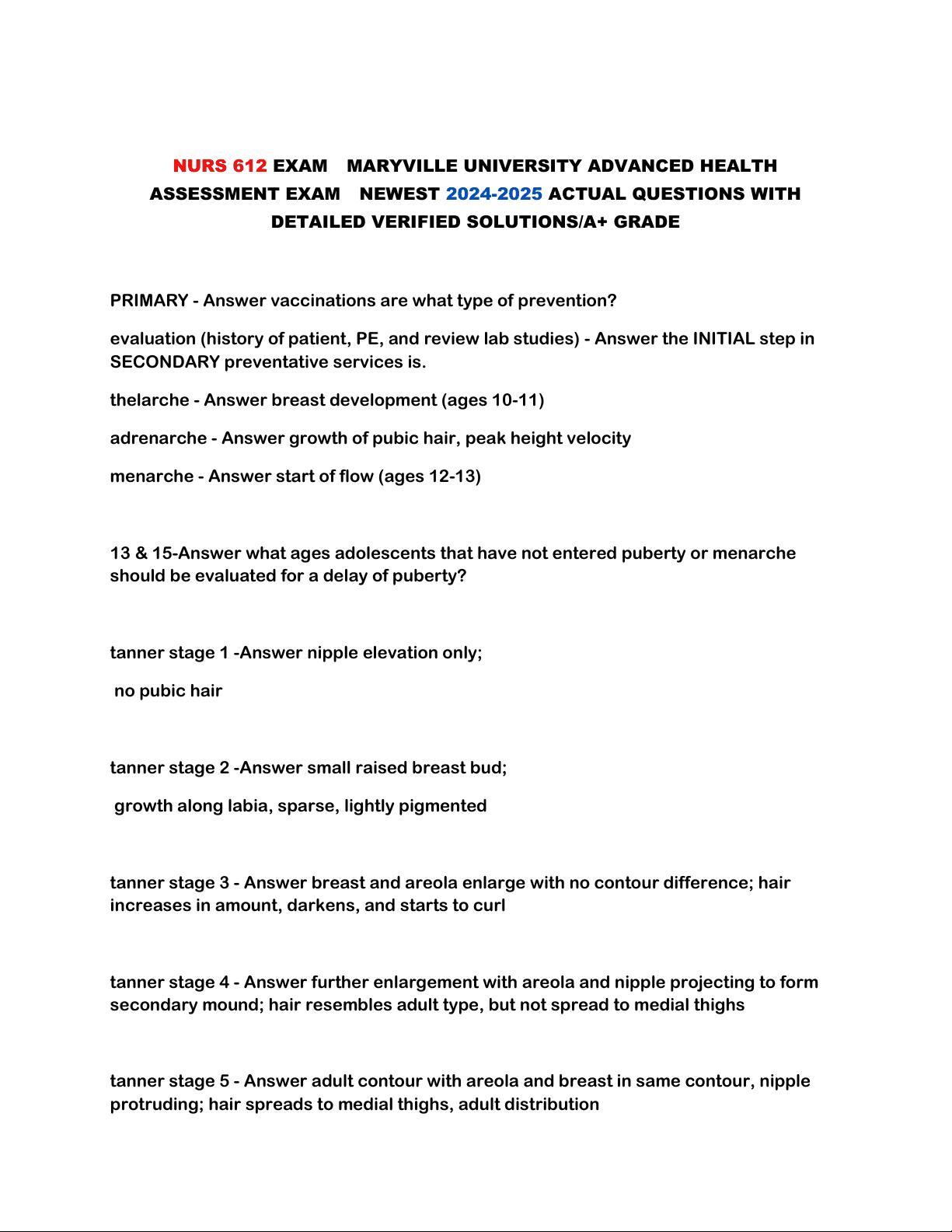











Study with the several resources on Docsity

Earn points by helping other students or get them with a premium plan


Prepare for your exams
Study with the several resources on Docsity

Earn points to download
Earn points by helping other students or get them with a premium plan
Community
Ask the community for help and clear up your study doubts
Discover the best universities in your country according to Docsity users
Free resources
Download our free guides on studying techniques, anxiety management strategies, and thesis advice from Docsity tutors
A comprehensive set of questions and answers related to the nurs 612 advanced health assessment exam at maryville university. It covers a wide range of topics, including female reproductive health, pregnancy, and newborn care. Designed to help students prepare for the exam by providing detailed explanations and verified solutions.
Typology: Exams
1 / 17

This page cannot be seen from the preview
Don't miss anything!










PRIMARY - Answer vaccinations are what type of prevention?
evaluation (history of patient, PE, and review lab studies) - Answer the INITIAL step in SECONDARY preventative services is.
thelarche - Answer breast development (ages 10-11)
adrenarche - Answer growth of pubic hair, peak height velocity
menarche - Answer start of flow (ages 12-13)
13 & 15-Answer what ages adolescents that have not entered puberty or menarche should be evaluated for a delay of puberty?
tanner stage 1 -Answer nipple elevation only;
no pubic hair
tanner stage 2 -Answer small raised breast bud;
growth along labia, sparse, lightly pigmented
tanner stage 3 - Answer breast and areola enlarge with no contour difference; hair increases in amount, darkens, and starts to curl
tanner stage 4 - Answer further enlargement with areola and nipple projecting to form secondary mound; hair resembles adult type, but not spread to medial thighs
tanner stage 5 - Answer adult contour with areola and breast in same contour, nipple protruding; hair spreads to medial thighs, adult distribution
GTPAL Answer gravida - # of pregnancies term - # of pregnancies that reached 37 weeks preterm - # of pregnancies 20-36 weeks abortions - # of spontaneous/induced < weeks living children pelvic organ prolapse - stage 1 most distal portion of the prolapse is >1 cm above the level of the hymen Answer
pelvic organ prolapse - stage 2 - Answer most distal portion of the prolapse is less than or equal to 1 cm proximal to or distal to the plane of the hymen
pelvic organ prolapse - stage 3 - Answer most distal portion of the prolapse is >1 cm below the plane of the hymen
pelvic organ prolapse - stage 4 - Answer complete eversion of the total length of the vagina
tail of spence / upper outer corner - Answer most malignancies of the breast are found here.
benign prostate hyperplasia - Answer prostate is diffusely smooth and enlarged
prostate cancer - Answer nodular and unusually firm
acute bacterial prostatitis - Answer warm, tense, boggy, very tender
chronic bacterial prostatitis - Answer normal, boggy, or focally indurated
efficacy - Answer how well a method works describes the likelihood that an unintended pregnancy will occur even when the method is used consistently and exactly as prescribed
effectiveness - Answer how well a method works in actual practice describes all unintended pregnancies that occur if a method is not used properly
Depo-Provera (progesterone only Q12-13 weeks) - Answerecommend HCG urine before administration of first two injections
Yupze, levonorgestrel, ulipristal acetate regimens, and copper IUD - Answermay all be used within 120 hours of UPI
Plan B One-Step, Next Choice One-Step, Yuzpe method - Answer must use within 72 hours of UPI
Missed 1 day of OCP -Answer take 2 pills now and continue w/ same pill pack
Missed 2 consecutive days (or >48 hours since last pill)-Answer Take most recent missed pill ASAP, discard any remaining missed pills, continue taking remaining pills at usual time; use backup contraception until hormonal pills have been taken for 7 consecutive days
Missed pill on the last week of hormonal pills- Increase the number of skipped hormone free pills, by completing the hormonal pills in the current pack then start a new pill pack the next day; backup contraception should be used until hormonal pills are taken for 7 consecutive days
Sonohysterosalpingography - Sterile saline and air is instilled into the uterus via the cervix to confirm the outline of the uterine cavity
hysterosalpingography - Answer radiopaque contrast is introduced through the woman's cervix into her uterus; the contrast is then passed through the fallopian tubes and is visualized via x-ray
hysteroscopy - Answer permits the practitioner to view the uterine cavity and endometrium; utilized for definitive diagnosis and therapy of intrauterine disorders causing infertility
laparoscopy - The provider is able to see the external surfaces of the uterus, tubes and
ovaries with the use of a laparoscope; helpful in diagnosing structural changes, endometriosis or pelvic adhesions
induction of ovulation medications - Clomid (clomiohene citrate), Femara (letrozole), Exogenous gonadotropins (FSH - Follistim, Gonal-F; FSH and LH - Pergonal, Menopur; Ovidrel)
luteal phase deficiency-Practice Committee of the ASRM DOES NOT recommend the treatment of luteal phase deficiency unless the woman has ovulatory dysfunction; can be treated with progesterone starting 2-3 days after a positive LH surge and lasting between 7-9 weeks gestation
fresh cycle transfer-Answer positives=cheaper, faster time to pregnancy, more long-term data; negatives=lower success rates or higher OHSS risk, risk of preterm deliverly and smaller babies
FROZEN CYCLE TRANSFER-Answer positives=higher success rates for women with high progesterone at trigger, endometriosis, PCOS, ASIAN and AA ancestry, safer in OHSSvulnerable pts, GENETICALLY TEST EMBRYOS; Negatives=Little long-term data, risk for pre-eclampsia and larger babies
GIFT - Gamete intrafallopian transfer - Answer Fertilization occurs in vivo instead of in vitro oocyte and sperm are both placed directly into the fallopian tube via laparoscopy so that fertilization can occur Must have at least one patent
zygote intrafallopian transfer (ZIFT)-Answer ovaries are hyper-stimulated and the ova are removed then fertilized in vitro, like IVF; the zygotes are placed in the fallopian tubes laparoscopy the day after fertilization
Hegar's sign-Answer softening of the lower uterine segment
by 12 weeks gestation-Answer fundus located at level of symphysis pubis
pregnancy
Group B strep high risk factors -Answer high risk factors include: gestation <37 weeks, premature rupture of membranes for >18 hours, maternal temp of 100.4 or higher, positive nucleic acid amplification test
Trichomoniasis -Answer characterized by a foul smelling vaginal discharge that is profuse, frothy, and green; treatment in pregnancy = Metronidazole 2 gm PO, lactating mother = Metronidazole 400 mg TID x7 days
Syphilis - Anwer if contracted before 28 weeks, the newborn is at risk for developing
Ectopic pregnancy - Answer symptoms = severe pelvic/abdominal pain and unexplained vaginal bleeding along with cervical motion tenderness, uterus not enlarged, and adnexal mass and tenderness
gestational trophoblastic disease (molar pregnancy)-Answer risk factors=age <20 or
40, history of, living in Asia, South Pacific, or Mexico; symptoms= vaginal bleeding, abd tenderness, severe N/V persisting after 12 weeks gestation, extreme fatigue, pelvic pain, coughing, SOB, hemoptysis, and weight loss; AVOID PREGNANCY FOR 6- MONTHS***
gestational trophoblastic disease (molar pregnancy)-Answer ultrasound will reveal snowstorm pattern, absence of fetal parts, and absence of fetal movement
preterm birth-Answer birth that occurs between 20 0/7 weeks and 36 6/7 weeks
preterm labor-Answer onset of regular contractions resulting in cervical change between 20 and 37 completed weeks of gestation
gestational diabetes - Explain all women should be screen between 24 and 28 weeks; if greater than 130-140, should undergo 3 hour GTT
Rhogam administration - Explain if Rh-negative mother is positive with Rh-positive fetus, administration of this helps prevent antibodies; 1st dose by 28 weeks and 2nd dose within 72 hours after birth
oligohydramnios - Explain less than 500 mL of amniotic fluid at 40 weeks gestation
polyhydramnios - Answer more than 1.5 to 2L of amniotic fluid
Abrupt, spontaneous rupture of membranes - Answer may be associated with prolapse of the umbilical cord, which is an EMERGENCY!!!
umbilical cord prolapse - Answer -place mother in lateral or knee-chest position to take pressure off of cord
-take pressure off of cord by placing gloved hand into the vagina, remaining in this position during transport
-monitor fetal heart rate
-administer maternal oxygen
-establish IV access
preeclampsia - Answer -blood pressure >140/
-proteinuria of +1 on 2 occasions 4 hours apart or 300 mg or greater in a 24 hour time frame or absent proteinuria but with the presence of thrombocytopenia, renal insufficiency, impaired liver function, pulm edema, or CNS or visual changes
preeclampsia risk factors - Answer risk factors include:
-nulliparity
->35 yo
-african american ethnicity
-family or personal hx of
bright red vaginal bleeding!!!
-sudden onset of sharp localized abd pain
-mild back and abdominal cramping
-uterine tenderness
-maternal abd board-like upon palpation
Placenta accreta - Answer Incorrect implantation of placenta into the myometrium, common symptom is vaginal bleeding
lochia - Answer discharge from the vagina after delivery;
-rubra = days 2-7, dark red
-serosa = days 7-22, lighter red
-alba = weeks 2-6, white/yellow
ovulation - Response is return in 45-94 days for non-breastfeeding postpartum women
combined oral contraceptives - Response is contraindicated until 21 days postpartum due to increased risk for VTE
Nipple candidiasis - Response is typically bilateral with abrupt onset, deep red discoloration, burning, shooting and stabbing pain in both nipples that occurs during and after breastfeeding
puerperal infection - Answer infection of the genital tract following childbirth, miscarriage, or termination; can occur secondary to other causes; c section is most common risk factor
puerperal fever - Answer temperature of greater than 100.4 that occurs on any 2 days (after the first 24 hours) within the first 10 days postpartum
subinvolution of uterus - Answer is when restoration of the uterus is interrupted and unable to return to pre-pregnant size during usual postpartum timeframe; symptoms include increased and continued bleeding as well as cessation and then return of the bleeding; boggy, larger than expected uterus
puerperal hematoma - Answer occurs when extravasated blood accumulates as a result of vascular trauma during birth or the birth procedure; s/s include persistent bleeding despite a firm uterus, increased vulvar, vaginal, or rectal pain and pressure, presentation of fluctuant edema with bluish discoloration
Postpartum thyroiditis - Answer can present anytime during the first postpartum year (usually 1-4 months), may see thyroid storm (fever, N/V, diarrhea, tachycardia, tremor)
APGAR - Answer appearance, pulse, grimace, activity, respiration - completed at 1 and 5 minutes
New Ballard Score - Answer Gestational age assessment based on neuromuscular and physical characteristics.
caput succedaneum - Answer diffuse swelling of the soft tissue of the scalp, possibly underlying bruising, usually crosses suture lines**
Cephalohematoma - Answer collection of blood in the subperiosteal area of the scalp, does not cross suture lines***
cleft lip-develops between 4th-7th week of pregnancy
cleft palate-develops between 6th-9th week of pregnancy
Polydactyly-gradual development of > normal # of fingers or toes
syndactyly-webbed fingers or toes
emergency!!! will see excessive oral secretions, choking, coughing, cyanosis, spitting, vomiting
Hirschsprung disease -Most common symptom = no stool passage in 48 hrs of birth; may have swollen abdomen and vomiting; most common cause of neonatal obstruction of colon
Duodenal atresia - Congenital maldevelopment or absence of duodenum; associated with Down's, maternal polyhydramnios, and prematurity
volvulus-Answer occurs in the newborn; an abnormal rotation of the viscera that results in ischemia; will see abd distention and bilious vomiting
pyloric stenosis-Answer occurs in the newborn; FIRM OLIVE LIKE MASS IN RUQ; narrowing of the pyloric sphincter; will see PROJECTILE vomiting beginning at 2- weeks old
imperforate anus - Answer congenital abnormality in which the bowel fails to perforate or only partially perforates the pelvis muscular floor; failure to pass meconium, constipation, and/or signs of intestinal obstruction
omphalocele - Answer protrusion of the intestines into the base of the umbilical cord where the intestines are covered by the peritoneum without overlying skin
Gastroschisis - Answer protrusion of the intestinal contents with no protective peritoneal covering
Necrotizing enterocolitis-question life-threatening GI emergency that occurs in newborn period; triad of abdominal distention, bloody stools, and feeding intolerance; often seen 3-10 days after initiating feedings
Meconium ileus-question failure to pass meconium within 48 hr of life; associated with cystic fibrosis and maternal polyhydramnios
diaphragmatic hernia-Answer abdominal contents herniate into the thoracic cavity; will see respiratory distress and breath sounds may be auscultated in the chest
umbilical hernia-Answer abnormal bulge seen or felt at the umbilicus; most resolve by 1 year; surgery not warranted unless nonreducible or persists beyond age 4-
Neuroblastoma-most commonly diagnosed neoplasm in neonates, majority develop in the abdomen, unexplained fever, mass and symptoms related to the size of the tumor; ascites and/or firm, irregular, nontender mass in the abdomen
Congenital hydrocephalus-head circumference enlarging, cranial sutures separated by large, tense fontanelles
Intraventricular hemorrhage-will usually see within the first 72 hours of life, diminished or absent reflexes, poor muscle tone, lethargy
Hypoxic-ischemic insults- three stages of hypoxia, infants may exhibit apnea, pallor, cyanosis and bradycardia unresponsiveness to stimulation; seizure activity can result
Myelomeningocele- failure of the posterior neural tube and vertebral column to close, most severe neural tube defect associated with history of poor prenatal intake of folic acid, exposure to hyperthermia, valproic acid, high mortality rate
Physiologic jaundice typically develops days after birth and resolves within 2 weeks.
Pathologic jaundice typically appears <24 hours after birth and may persist beyond 8 days
Kernicterus - Answer toxicity of the nervous system from high levels of bilirubin; common signs include lethargy, hypotonia, poor feeding, loss of moro reflex; later signs include decreased tendon reflexes, resp distress, failure to suck, opisthodomos,
Gonorrhea -Answer symptoms when present: dyspareunia, change in vaginal discharge, unilateral labial pain and swelling, lower abd discomfort; later symptoms: purulent discharge, rectal pain/discharge, menstrual irregularities with increased pain, fever, N/V, joint pain, upper abd pain; should be screened for annually <25 yo; treatment = Rocephin 250 mg IM x1 OR Cefixime 400 mg PO x1 PLUS Azithromycin 1 gm PO x1 or Doxy 100 mg PO BID x7 days (retest in 3 mo)
pelvic inflammatory disease (PID)-Answer may see abdominal pain after menses****, low back pain, abnormal vaginal discharge, postcoital bleeding, urinary frequency, N/V; treatment broad spectrum abx = Cefotetan plus Doxy OR Rocephin plus doxy with/without Flagyl
Syphilis - Answer systemic disease; STI; primary - chancre; secondary - generalized symmetrical rash of the hands and soles, Generalized lymphadenopathy, fever, headache, malaise, condyloma-like lesions; latent - asymptomatic; tertiary - cardiovascular, dermatologic, skeletal, and neuro symptoms.
syphilis treatment - Answer parenteral Penicillin G (all stages); single dose - primary, secondary, early latent; weekly treatment x3 - late latent, tertiary, or unknown duration; repeat clinical eval and serologic testing at 1, 12, and 24 months; watch for rare Jarisch-Herxheimer reaction (1st 24 hours of tx)
Jarisch-Herxheimer reaction - Answer Syphilis — overaggressive treatment of an asymptomatic patient that causes symptoms due to rapid lysis (flu like symptoms)
dysmenorrhea - AnSwer painful menstruation
menorrhagia - AnSwer excessive menstrual bleeding
metrorrhagia - AnSwer bleeding between periods
polymenorrhea - AnSwer the occurance of menstrual cycles more frequently than is
normal
oligomenorrhea - AnSwer menstrual periods >35 days apart
amenorrhea - AnSwer no period >6 months
Postcoital bleeding - AnSwer bleeding after intercourse, always consider cervical cancer
MPA (medroxyprogesterone) - AnSwer will use 4 months to avoid effects of unopposed estrogen if using Estrogen only oral contraceptive
One has to rule out endometrial hyperplasia and uterine cancer-answer before starting medical therapy in postmenopausal/perimenopausal bleeding
Primary amenorrhea - Failure of menarche, Answer absence of menstruation by 13 years with failure of development of the secondary sexual characteristics or by 15 years regardless of whether there has or has not been development of the secondary sex characteristics.
Amenorrhea-secondary
Ovarian cancer - risk >50% if >1 1st degree relative with this cancer; risk factors include eastern European or Ashkanazi Jewish background, have endometriosis, have never given birth or had difficulty getting pregnant